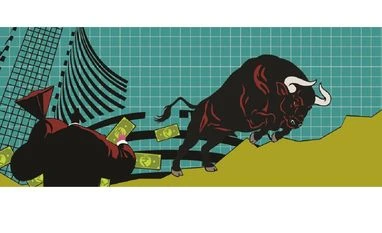According to conventional wisdom, growth in earnings drives stocks higher. But it is not so simple. Although earnings growth is expected to drive stocks higher, in reality, stock prices are determined by countless other factors, primarily impactful economic, social, and political events. Earnings growth is the only factor that is somewhat measurable and so we attach a lot of importance to it — perhaps more than what is justified. Anyone with some knowledge of market behaviour knows earnings and prices can diverge quite a bit. Earnings can be stagnant while stock prices rise, and vice versa. Even if you know the extent to which earnings will rise,it won’t help you forecast index movements; and yet, analysts have been at this futile exercise for decades. On the other hand, if you know that there will not be any significant rise in earnings, and do not invest, you could miss out on a serious market upmove.
Here is the evidence. In December 2022, the Nifty was over 18,800 and the earnings per share (EPS) of the Nifty50 was Rs 832. By March 2023, earnings had risen to Rs 849 but the Nifty was down 2,000 points. If you think this is a short-term issue, consider the five-year period between January 2015 and January 2020, most of which was a phase of great expectations from the Modi government’s first term. In January 2015, the Nifty EPS was Rs 392 and by January 2020, it rose a meagre 10 per cent to Rs 431.
How did the Nifty respond to this anemic growth over five years? It shot up 39 per cent! Like everything else in the markets, there is only a loose correlation between these two sets of variables. There are periods when the EPS and Nifty have risen in tandem and there are periods when they diverged, but divergence is a far more common occurrence. This is because very often, “sentiment” drives prices well beyond what is warranted and it is hard to forecast market sentiment. An extreme case of bad sentiment occurred between January and November 2008, when the Nifty crashed 57 per cent from 6,239 to 2,672, even as the Nifty EPS rose from Rs 222 to Rs 228. In short, the markets tend to diverge from earnings growth in both the short and long terms. Is that why “market experts” fall back on the economic narrative in support of higher (or lower) prices? But such narratives are even less connected to stock prices.
GDP growth vs stock prices
The centrepiece of the current narrative is strong economic growth. But GDP growth is also not strongly correlated with higher stock prices, which is evident from the average performance of the Chinese markets even during its high-growth years. At the same time, although India’s GDP growth has been higher, the US markets delivered better returns to international investors than the Indian markets.
In fact, the granular data underlying India’s economic growth does not look that strong. India’s private consumption is skewed — there is high consumption by a small number of the very rich at the top, while there is a slowdown in sales of mass-consumption items since the vast majority of the lower-income groups have been hit hard by inflation and poor income growth. India’s economic competitiveness hasn’t improved, either, as reflected by the slow growth of our merchandise exports. A few pockets of manufacturing excellence (which grab the headlines and are used to illustrate bullish narratives) don’t change the basic picture. The fact is that private investment has yet to pick up.
On the positive side, the stupendous state-led push in infrastructure building, railways, and defence expenditure will yield results. A handful of companies are getting big orders in engineering and construction as well as suppliers of pumps, wires, steel tubes, pipes, etc to these projects are reporting strong growth and their stocks will become multi-baggers. But it is hard to say how much this will benefit the economy. After all, even Larsen & Toubro, India’s largest construction company, reported only a 3 per cent compound annual growth rate in profits in three years, 4 per cent in five years, and 9 per cent in nine years. India’s largest cement company, Ultratech, reported a 4 per cent decline in profits over three years. Given these facts, while headlines about stock indices being at an all-time high may grab attention, it is senseless to predict where the Nifty is headed. That forecast would be determined by a narrative of our choice.
The writer is editor of www.moneylife.in and a trustee of the Moneylife Foundation; Twitter: @Moneylifers
To read the full story, Subscribe Now at just Rs 249 a month
Already a subscriber? Log in
Subscribe To BS Premium
₹249
Renews automatically
₹1699₹1999
Opt for auto renewal and save Rs. 300 Renews automatically
₹1999
What you get on BS Premium?
-
Unlock 30+ premium stories daily hand-picked by our editors, across devices on browser and app.
-
Pick your 5 favourite companies, get a daily email with all news updates on them.
Full access to our intuitive epaper - clip, save, share articles from any device; newspaper archives from 2006.
Preferential invites to Business Standard events.
Curated newsletters on markets, personal finance, policy & politics, start-ups, technology, and more.
Need More Information - write to us at assist@bsmail.in
)